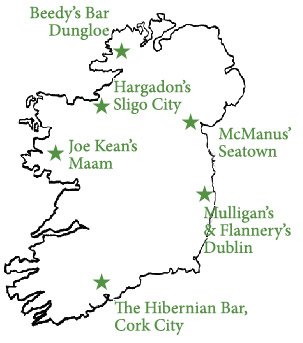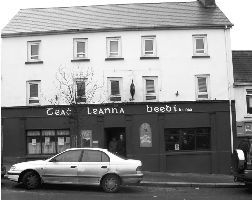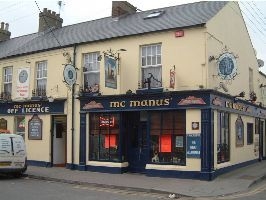Where Is The Absolute Best Pub In Ireland?
Six Irish writers pick the spots where pints of Guinness and life stories meet with the sweetest results

A Song With Writers, Failed Writers, Poets & Failed Poets The Hibernian Bar, Oliver Plunkett Street, Cork City
Climb up the stairs, turn right and push open the door. Its like stepping into someones private sitting room. The nine high chairs that hug the wooden bar will invariably be taken, mostly by men some of the citys best known characters writers and failed writers, poets and failed poets. This is Corks Hibernian Bar, affectionately known as the Hi-B. Its one of the citys most eclectic and eccentric pubs . Brian, the proprietor, ivory skinned with thinning white hair, will greet you with a witty quip. Of course, thats only if he takes to you. If you seem suspect, you will at best be given the once-over with a frosty eye. At worst, youll be barred on the spot. The last time I saw Brian, he quoted me a nugget of good advice for life: Have something to love, something to do and something to hope for.
The Hibernians floor is covered in red lino. Along the burgundy walls are leatherette sofas to sink into and, often, the deflated balloons remaining from some past event. Brians latest dictates are posted on the mirror behind the bar: Absolutely positively no mobile phones, and a favorite, Those who drink to forget, please pay in advance.
Secluded Spot
Years ago, I did a lot of my courting in the Hi-B. Wed sit in the window with rum and blacks, and if not taken by events in the pub, we would turn our backs and look out the window onto a Cork Saturday night. The Hi-B sits on the corner of Oliver Plunkett Street and the narrow Winthrop Street, above a pharmacy and below the Cork Academy of Hairdressing. Being upstairs creates a sense of seclusion and intimacy.
One recent weeknight, I stop in, not to get my usual advice from Brian, but to hear Dick OSullivan play piano. Wednesday is piano night. Dick wont start playing until around 10pm, so we pass the time drinking glasses of Murphys (Corks answer to Guinness). When Dick finally brings out the piano, some kind of light-frame keyboard actually, the place is energized. Dick, white-haired and wearing heavy tweed trousers, starts with Aint Misbehavin, following with Down by the Sally Gardens. When Dick sings, the whole pub sings. After each song, the audience roars out with cheers and applause. People come to the piano to sing solo, while others croon from the safety of the bar. The Hi-B has taken on a dynamic and charm that relates only to this moment. It has none of the contrived atmosphere of the super pub. Dick finishes up with some fast finger work. We all clap again and he directs us to a sign over the bar: No Dick for two weeks. Hes going on holiday, but we all savor the innuendo, and laugh the nights last laugh.
Where the Guinness is Properly Topped-Off Beedys Bar, Dungloe, County Donegal

Beedys is a family affair, where your drink will have a collar solid enough to trot a mouse across. Set a handsome three-story building on Main street, Dungloe (a picturesque seaside town in northwest Donegal) it is hearth and home to local artists, poets, actors, musicians and anglers who all have one thing in common a love of the traditional-style bar, where the atmosphere is always welcoming.
Three generations of the same family have run Beedys for over 70 years. It was opened by a local, Patrick Doherty, who had spent 20 years as one of the Tunnel Tigers in New York, working on the Brooklyn Bridge and the subway system. In 1932, he shipped his family back home to Ireland and opened the pub. His daughter Beedy (short for Brigid) took over its management some fifty years ago and gave the place its charming stamp with her handsome, soft-spoken presence.
From the time my family first came to Dungloe, back in the 1960s, Beedy was always the oracle you consulted when your life went amiss. If you needed to find an experienced turf-cutter to bring in the turf from your bog, Beedy knew the right man. If your car broke down on the way into town, Beedy sorted out a lift home and a tow to the garage the next day. There was nothing she couldnt handle, including five-star catering. Her spare-rib suppers were legendary wonderful pork, ribs piled high in big dishes, along with side orders of boiled cabbage and buttery potatoes. You ate until your own ribs strained at the seams. Then you drank pints of creamy buttermilk or Guinness and drowsed by the fire.
New Regime
In due course, Beedy retired, leaving her business in the capable hands of son David and daughter-in-law Moya. They brought more live music into the lounge and added a beer-garden out back, but kept the original atmosphere. In the front bar, its more like a night in a neighbors cozy parlor than a public premises. The pint of Guinness in Beedys is still pulled in several stages, and allowed to rest before its topped off with a creamy collar solid enough to trot a mouse across. On Sunday evenings in winter, there are baskets of steaming mussels, razor-fish, cockles and winkles to eat, collected earlier by hardy regulars trawling the beach at low-tide. At times like this you feel that if things got any better at Beedys, we wouldnt be able to bear it.
No Fake Orish Pub This! McManus’, Seatown, Dundalk, County Louth

My formative drinking years were spent in McManus’, in Seatown, Dundalk, a small coastal town 60 miles north of Dublin. Like most “ye olde world” pubs, McManus has an old-fashioned signpost on the wall and an ancient aul fella propping up the bar. But unlike the cookie-cutter “Oirish” pubs , which trade on shamrock and leprechaun themes rather than substance, McManus’ has real personality.
cManus is colorful and a bit funky. Ten years ago, you could find an international popstar at the pumps. The Corr sisters used to barmaid here to make some pocket money. A bright pink piano serves as the perfect spot to rest your pint while you socialize. The beer garden out the back has a real fire going – summer or winter. It was a smokers paradise way before the government decided we should all kick the habit.
A former family house, McManus still retains a warren of rooms and cubbyholes, and the atmosphere of a home. Add into the equation the perfect separation of age groups – old fogeys in the front lounge, college kids in the back bar and the under-aged outside in the nearby graveyard chugging cider- and it manages to be all things to all people! McManus may be dark (even dingy), but its grimy walls are testament to the generations of locals whove drunk there. Who cares how often the old school house benches and brass door knobs have been polished, so long as the pints are flowing!
A Relaxing Pint in a Rural Western Village Joe Keanes, Maam, Connemara
In the mid-1990s Pete McCarthy wrote a cracking travelogue titled McCarthys Bar. The basic gist of it is that somewhere, theres a rule that says you should always go into a pub that bears your name on the door. From this premise came a book full of colorful tales of wandering in and out of McCarthy bars, mostly in County Cork, over a period of several years. Since reading it, Ive kept an eye open for pubs bearing my own name and visited many. But I have a particular fondness for Joe Keanes in the small village of Maam, in Connemara.
I dont remember when I first set foot in the place probably six or seven years ago but its a pub I happily return to whenever Im in the area. The truth is, you can get a Guinness anywhere. Whats more difficult to find is a comfortable pub where you can choose to be social or quiet, and feel at home either way. Joe Keanes in Maam is just the place.
A Tiny Outpost
From the outside, its a two-story grey building (accommodation also available) covered in ivy and neatly tucked in under the trees, with the mountains rising behind it. Save for a small shop next door, a bridge and a small stream across the road, theres little else in Maam. (Not to be confused with Maam Cross, home of Quiet Man cottage and tourist kitsch.)
At a time when more and more pubs feature loud background music or a TV blaring in the corner, Keanes pub is a welcome reprieve. The bar area to the front is a no-nonsense space. With a pint of black and the right mix of locals, you never know whom youll get chatting to. A small notice board mounted on the wall by the bathrooms holds various newspaper cut-outs (some of them yellowed with age) and fishing news from the local area. Its a small detail, but I make a point of stopping for a quick read each time, delighting in the fact that there are no overt tourism displays in sight.
The lounge at the rear is my favorite part, with its soft low lighting and its mish-mash décor. It feels halfway between being a pub and someones living room with the round bar, the well-worn armchairs and the piano in the corner. A blazing fire seems to be going most of the year, and once you get settled in beside it, its hard to move. Ive seen literally hundreds of people over the years come in wet and cold after a day on the hills, and settle down to warm their toes while enjoying a toasted sandwich and a hot brandy.
Besides being a comfortable place for food and drink, Keanes greatest quality is that there is no rush on you. Ive stopped off for breaks from summer heat and winter rain countless times and no matter how long I stay, I always feel welcome to hang on a while longer if I want. With all things combined, its a gem as pubs go, and one of my favorite places in Ireland. If youre in the area, be sure to stop off for one or two.
To reach Maam: take the N59 from Galway toward Clifden. About 25 miles from Galway City, turn right at Maam Cross; drive about 5 miles more and youll be in Maam.
The Cream of Classic Dublin Pubs Mulligans of Poolbeg Street & Flannerys, Dublin
If you’re at all like me, youd rather be hanged from the nearest tree than be seen in a contrived tourist trap pub. To gain a glimpse of the true Dublin pub, you must cancel your tour bus arrangement and discard all travel guide literature. They may be useful for reaching various landmarks, but will most assuredly prove useless if the intended destination is a true natives haunt.
Two public houses to seek out if you want a taste of true Dublin are:
Mulligans of Poolbeg Street
This is one of the oldest Dublin pubs, and also happens to serve the best pint of Guinness to put past your lips in the capital. If you fancy pre-Georgian decor with lots of pine and oak everywhere with space enough for a trapeze artist to perform above your head, then you’re sorted. The bar staff is more than courteous, unless of course you’re insistent on allowing your most anti-social cell phone to destroy the conversation and craic with cacaphonous rings. Mobile phones, by the way, are prohibited. (011 353 1 677 5582).
Flannerys, on Camden Street
This pub is a social institution. Fortunately, only a small few of its patrons have ever been institutionalized. At Flannerys, it is not uncommon to meet people from anywhere and everywhere in Ireland. On a Saturday evening or after a Sunday game, lads and ladies from Kilkenny to Donegal can be found having the banter in this upbeat music bar. An American in Flannerys is definately the odd man out. For once, the foreign visitor is something of a novelty (quite rare nowadays in Ireland) for the natives to view and ponder and even poke at. God forbid, one or two may even chat you up (011 353 11 478 2238).
A Window Seat for Those Trying to Recover Hargadons, Sligo City, County Sligo
Hargadons sits on OConnell St., the main thoroughfare of Sligo City. How do you find it? Easy – it stands out in the colorful streetscape for its very understated 19th century dullness. With such an introduction why would you want to find it?
With Sligo growing quickly from a big rural town into a small city, Hargadons retains its ould character. Its been serving patrons on the same spot for well over 100 years. The old wood panels subdue the street glare coming in the window and reflect onto a once-white ceiling. Cream is the colour you might call it on a good day. Tobacco smoke colored it for years, until the vice was outlawed.
A Tincture in the Snug
There are two bars within. Your pint can be taken at the short counter on your right as you enter. If, however, you have reason to seek privacy, you can move to the haven of maiden aunts: the snug. In this small side room, a deorum (a bit of whiskey, from deor, the irish word for drop) can be passed to you surreptitiously through the porthole at the end of the bar, out of the gaze of other bar patrons. This is a relic of the old days, which once gave comfort to ladies who separated from their husbands of a fair day and imbibed a medicinal tincture.
Hargadons has a special spot for those recovering from a rough night. Its a window seat, large enough for three poor souls (the glass, of course, is opaque). This is the life boat, where theres no need to call the barman. Hell show up to ask what you need. Just dont expect too much conversation from anyone who joins you here.
If youd simply like a sandwich, a pint, a newspaper and a bit of quiet, the benched cubicles are ideal. The pub is long and narrow. At the back is a small eatery which caters all. You need not even have a pint to enjoy a quick snack here.
Hargadons has survived as a haven of peace, and you will not find a radio, television or other 21st century interferences inside. No live music, good or bad, will assail your senses. Did I mention that the pint here is excellently pulled, allowed to settle and it arrives with a proper head? Sorry! I took that for granted.